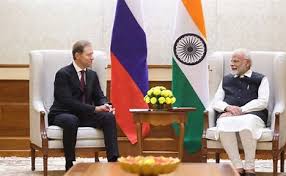 India has shown the industrialised countries they can longer have their way in multilateral trade negotiations at the expense of the developing world. The WTO General Council meeting that concluded in Geneva on July 31 failed to approve the protocol of amendment proposed by the 9th ministerial conference in Bali for enshrining the Trade Facilitation Agreement (TFA) into the WTO Marrakesh Agreement.
India has shown the industrialised countries they can longer have their way in multilateral trade negotiations at the expense of the developing world. The WTO General Council meeting that concluded in Geneva on July 31 failed to approve the protocol of amendment proposed by the 9th ministerial conference in Bali for enshrining the Trade Facilitation Agreement (TFA) into the WTO Marrakesh Agreement.
The general council meeting that extended beyond midnight could not resolve the issue as India insisted that talks on food security and public stockholding for the purpose should move at the same pace with that for TFA. India has said that there has been lack of progress towards finding a permanent solution to its food security concerns.
In the Bali ministerial meeting in December last year, the developed countries contested India’s new National Food Security Programme, saying that it breaches its permissible level of 10% de minimis subsidy level. Under the stiff opposition of developed countries in Bali, India had to settle for an interim Peace Clause arrangement until a permanent solution is found at the 11th WTO Ministerial Meeting in 2017 under the agreement on ‘Public Stockholding for Food Security Purposes’.
Strangely, the Bali Ministerial concluded without discussions on the WTO Agreement on Agriculture that still remains heavily tilted in favour of the developed world. The subsidies given to agriculture in developed countries run into billions of dollars. There has been slow progress in eliminating export subsidies given by the developed world that was agreed upon nine years ago and would have been eliminated by 2013.
The erstwhile UPA government that got the Food Security Act 2013 enacted, providing right to food to two-thirds of India’s population or 820 million people, buckled to pressure and accepted a temporary solution through a Peace Clause ensuring that member countries will not sue India in the dispute settlement mechanism even if its de minimis subsidies go beyond the 10% permissible limits. By offering this temporary solution, the US managed to get binding commitments from developing countries on the agreement on Trade Facilitation, that would require countries to invest in infrastructure to speed up customs clearances and help facilitate trade. Trade facilitation is nothing but import facilitation and requires upgrading infrastructure at borders, ports, and custom procedures to boost excessive imports from developed countries. The Bali Ministerial further mandated to approve by July 31, 2014 the protocol of amendment enshrining the TFA into the WTO Marrakesh Agreement, while a permanent solution to the food security concerns of India and other developing countries would be decided in 2017.
It is laudable that the new NDA government under Prime Minister Narendrabhai Damodardass Modi had put food security concerns of the developing world in the forefront of the global agenda. This is the first time that India has vetoed a proposal in the WTO without caring about international isolation. A few countries like Bolivia, Cuba, South Africa, Venezuela and Zimbabwe have backed India.
In the history of WTO, it is usually alliances like US-EU, Cairns group, G-20 (an alliance of developing countries formed when Arun Jaitley was India’s Commerce Minister), G-33, ACP group that worked out a compromise formula amongst themselves for getting a deal through. But this time India almost stood alone to defend its food security concerns.
The WTO General Council met on July 24 and 25, but subsequently suspended the meeting in case of a last-minute breakthrough on the TFA protocol, but continued till midnight of July 31-August 1. India has said that the adoption of the TFA protocol should be postponed till a permanent solution on public stockholding for food security is found. A permanent solution should be reached by December 31 this year, with a meeting of the General Council in October to review progress of these accelerated discussions”. A special session of WTO Committee on Agriculture should be held and talks should be held under other institutional mechanisms. Such an approach should also be adopted for other decisions reached in Bali, particularly those relating to least developed countries.
According to the Peace Clause agreed upon in Bali, India will find difficult to expand its food security by including more crops or by increasing support prices to farmers. It will be limited to staples like wheat and rice. Pulses and cooking oil will not be considered as items for food security. Countries that do not have public procurement and stockholding for food security cannot initiate the process. Stringent conditionalities are imposed by this agreement, which says that member states must ensure ‘that stocks procured under such programs do not distort trade’, and do not adversely affect food security of other members. These are quite broad, and any large domestic programme can be challenged later as trade distorting.
Besides, difficult notification and transparency requirements put extra burden on India or any other country availing the Peace Clause to submit their domestic support notification annually. They have to provide additional information for each public stockholding programme they maintain for food security purposes. Most developing countries cannot comply with this onerous data submission, and if they do, they would unnecessarily open up their domestic policies, programmes, and mechanisms to international scrutiny.
Compared to the massive trade distorting subsidies given by the US and the EU, India’s subsidy under the new food security programme is only Rs 90,000 crore and is intended to fulfil the UN Millennium Development Goals.
The criteria in the Agreement on Agriculture need to be rectified at the earliest. The developed countries are continuing with their massive subsides under Blue Box, Green Box and other boxes and are taking advantage of the computation of their level of allowable subsidy on the basis of the base year 1986-88, that now needs to be changed.
The European Union gives massive to only 5 per cent of its citizens engaged in farming which generates just 1.6 per cent of its GDP. EU’s Common Agriculture Policy (CAP) accounts for more than 40 per cent of its annual budget. In 2013, the budget for direct payments to farmers as subsidy and rural development – the twin pillars of CAP – is 57 billion euros or 49 billion pounds, out of the total EU budget of 132.8 billion euros –amounting to 43 per cent of the total.
Strangely, subsidies are also given for keeping the lands fallow, citing environmental reasons.
At present, direct payments and price support account for more than 70 per cent of the CAP budget, while rural development gets less than a quarter. Direct payments account for more than half of the farmers’ income in EU. The average annual subsidy per farm is about 12,200 euro or 10,374 pound. Large agri-businesses and big landowners get more from CAP than Europe’s small farmers who rely on traditional methods and local markets. About 80 per cent of the assistance goes to about a quarter of EU farmers with large landholdings like the British royal family and European aristocrats with big inherited estates. The older 15 EU members benefit more than the new members.
Milk quotas protect the income of dairy farmers. Though the EU had promised to phase out this trade distorting measure by 2015, it is raising the quota by one per cent each year so that a high level is reached before phasing out begins. The sugar industry is adequately protected by high guaranteed price.
The United States is not behind in the race. The US food stamp programme is pegged at $60 to 70 billion every year. The support given to farmers in US is less transparent than that in the EU. The 2013 US Farm Bill gives unlimited crop insurance subsidy. Some policyholders get more than $ 1 million annually in premium support and more than 10,000 policyholders receive more than $100,000 in subsidies. As there is no cap on crop insurance subsidies, the largest one per cent among policyholders get about $227,000 annually while the bottom 80 per cent receive about $5,000. Crop insurance subsidies flows largely to agri-business corporations and farmers with large landholdings.
Unlike other farm subsidies, crop insurance subsidies are not subject to means testing or payment limits and farmers are not required to adopt basic environmental protects. The crop insurance scheme cost the taxpayers about $9 billion a year.
(Ashok B. Sharma is a senior journalist who has written extensively on WTO-related issues. The views expressed in this article are solely those of the author).
Author Profile
- India Writes Network (www.indiawrites.org) is an emerging think tank and a media-publishing company focused on international affairs & the India Story. Centre for Global India Insights is the research arm of India Writes Network. To subscribe to India and the World, write to editor@indiawrites.org. A venture of TGII Media Private Limited, a leading media, publishing and consultancy company, IWN has carved a niche for balanced and exhaustive reporting and analysis of international affairs. Eminent personalities, politicians, diplomats, authors, strategy gurus and news-makers have contributed to India Writes Network, as also “India and the World,” a magazine focused on global affairs.
Latest entries
 DiplomacyOctober 4, 2025UNGA Resolution 2758 Must Not Be Distorted, One-China Principle Brooks No Challenge
DiplomacyOctober 4, 2025UNGA Resolution 2758 Must Not Be Distorted, One-China Principle Brooks No Challenge India and the WorldJuly 26, 2025MPs, diplomats laud Operation Sindoor, call for national unity to combat Pakistan-sponsored terror
India and the WorldJuly 26, 2025MPs, diplomats laud Operation Sindoor, call for national unity to combat Pakistan-sponsored terror India and the WorldJuly 25, 2025When Fire Ends, Diplomacy Begins
India and the WorldJuly 25, 2025When Fire Ends, Diplomacy Begins India and the WorldJuly 16, 2025Operation Sindoor and its Aftermath: India’s Successful Diplomatic Outreach
India and the WorldJuly 16, 2025Operation Sindoor and its Aftermath: India’s Successful Diplomatic Outreach







